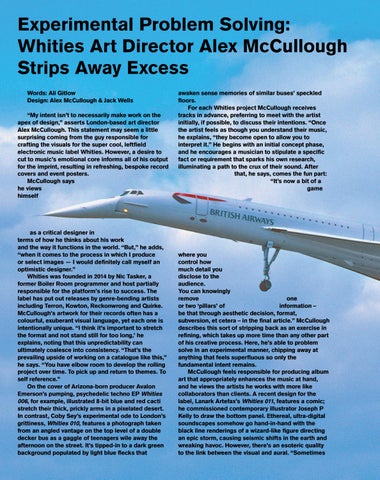Experimental Problem Solving: Whities Art Director Alex McCullough Strips Away Excess Words: Ali Gitlow Design: Alex McCullough & Jack Wells “My intent isn’t to necessarily make work on the apex of design,” asserts London-based art director Alex McCullough. This statement may seem a little surprising coming from the guy responsible for crafting the visuals for the super cool, leftfield electronic music label Whities. However, a desire to cut to music’s emotional core informs all of his output for the imprint, resulting in refreshing, bespoke record covers and event posters. McCullough says he views himself
as a critical designer in terms of how he thinks about his work and the way it functions in the world. “But,” he adds, “when it comes to the process in which I produce or select images — I would definitely call myself an optimistic designer.” Whities was founded in 2014 by Nic Tasker, a former Boiler Room programmer and host partially responsible for the platform’s rise to success. The label has put out releases by genre-bending artists including Terron, Kowton, Reckonwrong and Quirke. McCullough’s artwork for their records often has a colourful, exuberant visual language, yet each one is intentionally unique. “I think it’s important to stretch the format and not stand still for too long,’ he explains, noting that this unpredictability can ultimately coalesce into consistency. “That’s the prevailing upside of working on a catalogue like this,” he says. “You have elbow room to develop the rolling project over time. To pick up and return to themes. To self reference.” On the cover of Arizona-born producer Avalon Emerson’s pumping, psychedelic techno EP Whities 006, for example, illustrated 8-bit blue and red cacti stretch their thick, prickly arms in a pixelated desert. In contrast, Coby Sey’s experimental ode to London’s grittiness, Whities 010, features a photograph taken from an angled vantage on the top level of a double decker bus as a gaggle of teenagers wile away the afternoon on the street. It’s tipped-in to a dark green background populated by light blue flecks that
awaken sense memories of similar buses’ speckled floors. For each Whities project McCullough receives tracks in advance, preferring to meet with the artist initially, if possible, to discuss their intentions. “Once the artist feels as though you understand their music, he explains, “they become open to allow you to interpret it.” He begins with an initial concept phase, and he encourages a musician to stipulate a specific fact or requirement that sparks his own research, illuminating a path to the crux of their sound. After that, he says, comes the fun part: “It’s now a bit of a game
where you control how much detail you disclose to the audience. You can knowingly remove one or two ‘pillars’ of information – be that through aesthetic decision, format, subversion, et cetera – in the final article.” McCullough describes this sort of stripping back as an exercise in refining, which takes up more time than any other part of his creative process. Here, he’s able to problem solve in an experimental manner, chipping away at anything that feels superfluous so only the fundamental intent remains. McCullough feels responsible for producing album art that appropriately enhances the music at hand, and he views the artists he works with more like collaborators than clients. A recent design for the label, Lanark Artefax’s Whities 011, features a comic; he commissioned contemporary illustrator Joseph P Kelly to draw the bottom panel. Ethereal, ultra-digital soundscapes somehow go hand-in-hand with the black line renderings of a wizard-like figure directing an epic storm, causing seismic shifts in the earth and wreaking havoc. However, there’s an esoteric quality to the link between the visual and aural. “Sometimes
